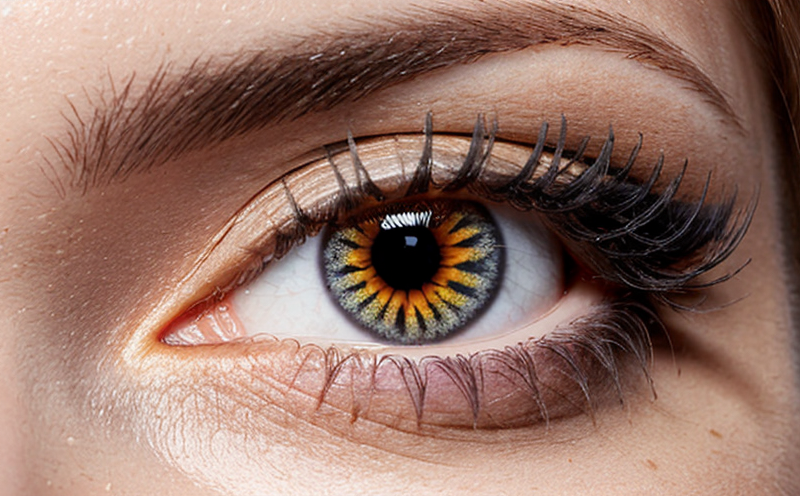Eye Irritation Testing for Contact Lens Solutions
The testing of contact lens solutions for eye irritation is a critical component in ensuring the safety and efficacy of these products. Eye irritation tests are designed to identify any potential harmful effects that could occur during wear or use of the solution. This service ensures compliance with regulatory standards, providing peace of mind for both manufacturers and consumers.
Contact lens solutions play an essential role in maintaining ocular health by keeping lenses clean and comfortable. However, the materials used in these solutions can sometimes cause irritation to the eyes if not properly formulated or tested. Regulatory bodies such as the US Food & Drug Administration (FDA) and the European Medicines Agency (EMA) have strict guidelines that mandate rigorous testing before any contact lens solution can be marketed.
The primary objective of eye irritation tests is to evaluate the potential for ocular discomfort, redness, and other adverse effects resulting from the use of a particular solution. These tests typically involve exposing human corneal cells or rabbit corneas to small amounts of the solution under controlled conditions. The response of these cells over time indicates whether there are any signs of irritation.
One widely recognized method for conducting eye irritation tests is through the application of the ISO 10993-10 standard, which outlines a comprehensive approach to assessing biological compatibility. This includes evaluating various aspects such as cytotoxicity (cell damage), sensitization potential, and ocular irritation.
In addition to adhering to international standards, it's crucial for laboratories specializing in this field to maintain high levels of accuracy and precision throughout all stages of testing. Proper specimen preparation is vital; this involves ensuring that each sample used in the test represents actual conditions experienced by users. This can include factors like temperature control during exposure periods or adjusting pH levels based on typical usage scenarios.
The results from these tests are then analyzed using statistical methods to determine whether the solution meets established safety criteria. Compliance with regulatory requirements ensures that consumers have access to safe and effective contact lens care products while protecting public health interests globally.
Industry Applications
- Contact Lens Manufacturers: To ensure their solutions meet strict FDA, EMA, and other international standards for ocular safety.
- R&D Engineers: For developing new formulas that minimize the risk of eye irritation without compromising effectiveness.
- Quality Managers: As part of ongoing quality control processes to maintain consistent product performance across different batches or formulations.
- Procurement Officers: To verify supplier compliance with specified standards before placing orders for large quantities of raw materials used in lens solutions.
Why Choose This Test
Selecting an appropriate eye irritation testing service is essential for several reasons:
- Regulatory Compliance: Ensures that your product complies with relevant regulations set by global bodies like the FDA, EMA, and others.
- Product Safety: Protects consumers from potential risks associated with ocular irritation due to improper formulation or manufacturing practices.
- Market Access: Facilitates easier entry into markets where stringent safety requirements apply. Meeting these standards can open up new customer bases for your company.
- Patient Confidence: Builds trust among end-users who value their ocular health above all else when choosing contact lens care products.
By investing in thorough eye irritation testing, you demonstrate a commitment to delivering high-quality products that contribute positively to overall well-being. This proactive approach not only enhances brand reputation but also fosters long-term relationships with satisfied customers who appreciate your dedication to safety and excellence.
Customer Impact and Satisfaction
The impact of choosing a reliable eye irritation testing service extends beyond mere compliance; it directly influences customer satisfaction and loyalty. When manufacturers can prove their products are safe for use, they create a foundation of trust that encourages repeat purchases and positive word-of-mouth recommendations.
For quality managers within organizations, having access to detailed reports on test outcomes allows them to make informed decisions regarding process improvements or adjustments needed to enhance product safety further. This data-driven approach ensures continuous improvement in manufacturing processes leading ultimately towards higher quality outputs.
R&D engineers benefit greatly from comprehensive insights provided by these tests as they can use this information to innovate safer yet effective solutions. They gain valuable knowledge about what works well and where improvements are necessary, driving innovation forward.
Lastly, procurement officers appreciate the peace of mind offered knowing that suppliers adhere strictly to specified standards, eliminating concerns related to quality inconsistencies or non-compliance issues down the supply chain.





